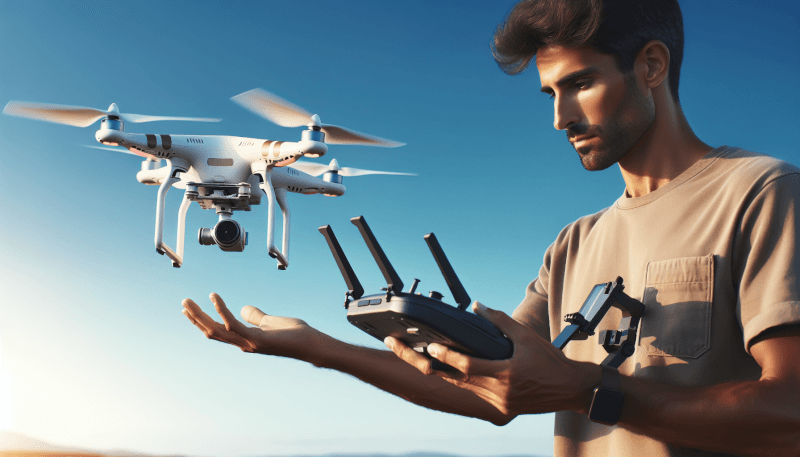Are you tired of your drone wobbling in the air or struggling to maintain a steady flight? Look no further! In this article, we will explore the top ways to enhance the stability of your drone during flight. Whether you are a beginner or an experienced drone pilot, these tips and techniques will help you achieve smooth and controlled flights, allowing you to capture stunning aerial footage with confidence. So, let’s get started and make your drone flying experience a whole lot more stable and enjoyable.

Proper Drone Configuration
Having a proper drone configuration is crucial for ensuring stability during flight. By balancing the center of gravity, optimizing propeller configuration, and setting the correct motor thrust, you can greatly improve the stability of your drone.
Balancing the Center of Gravity
One of the first things you need to do is to make sure that the center of gravity of your drone is properly balanced. This means that the weight of the drone is evenly distributed around its central axis. If the center of gravity is off, it can cause the drone to be unstable and difficult to control.
To balance the center of gravity, you can adjust the placement of components such as the battery and the camera. Make sure they are positioned in a way that evenly distributes the weight. You can also use tools like a balance stand or a bubble level to ensure that the drone is perfectly balanced.
Optimizing Propeller Configuration
The propellers play a crucial role in the stability and maneuverability of your drone. It is important to choose the right propellers for your drone and optimize their configuration.
First, make sure that the propellers are correctly attached to the motors and are secured tightly. Loose propellers can cause vibrations and affect the stability of the drone. Next, consider the size and pitch of the propellers. Larger propellers with a higher pitch provide more thrust and stability, but they might also drain the battery faster. Find the right balance based on your drone’s specifications and intended use.
Setting the Correct Motor Thrust
The motor thrust is another important factor in maintaining stability. Each motor should be generating the same amount of thrust to keep the drone level and prevent unwanted tilting or rolling.
To set the correct motor thrust, you can use a software program or consult the drone’s manual to find the recommended values. Adjust the motor speeds until they are all producing the same amount of thrust. This will help maintain stability during flight and ensure smooth maneuverability.
Calibrate Sensors and Compass
Calibrating the sensors and compass on your drone is essential for accurate flight control and stability. Proper calibration ensures that the drone’s internal systems are reading and interpreting data correctly.
Calibrating Accelerometer
The accelerometer is responsible for measuring acceleration forces on the drone. Calibrating the accelerometer involves placing the drone on a level surface and allowing it to detect and adjust to the level position. This calibration ensures that the drone can accurately measure pitch, roll, and yaw movements, maintaining stability.
Calibrating Gyroscope
The gyroscope is responsible for measuring the orientation and rotation of the drone. Calibrating the gyroscope involves allowing the drone to detect and adjust to its resting position without any external forces acting on it. This calibration ensures that the drone can accurately detect and respond to changes in its orientation, contributing to stability during flight.
Calibrating Magnetometer
The magnetometer is responsible for measuring the magnetic field around the drone. Calibrating the magnetometer involves rotating the drone in a circular motion, allowing the sensor to detect and adjust to the surrounding magnetic field. This calibration ensures that the drone can accurately determine its heading and maintain stability even in the presence of magnetic interference.
Improve Flight Controller Settings
The flight controller plays a vital role in stabilizing the drone during flight. By making the necessary adjustments and optimizations to the flight controller settings, you can significantly enhance the stability of your drone.
Tuning PID Values
PID (Proportional, Integral, Derivative) values are parameters in the flight controller that determine how it responds to different inputs, such as changes in thrust or angular velocity. By tuning the PID values, you can adjust the flight controller’s responsiveness and stability.
It is recommended to start with default PID values and make small adjustments to fine-tune the drone’s stability. Keep in mind that different drones and flight controllers may require different PID values, so experimentation and testing are crucial.
Enabling GPS Assistance
If your drone has a GPS module, enabling GPS assistance can greatly enhance stability, especially in outdoor environments. GPS assistance allows the drone to hold its position more accurately, even in the presence of external factors such as wind or turbulence.
By utilizing GPS assistance, your drone can maintain a stable hover, follow specific flight paths, and resist external disturbances more effectively. Enable this feature in the flight controller settings and make sure to give the GPS module enough time to acquire a sufficient number of satellites for accurate positioning.
Activating Altitude Hold Mode
Altitude hold mode is a useful feature that helps maintain a consistent altitude during flight. By activating this mode, the drone uses its barometric altitude sensor to measure and adjust its altitude automatically.
Altitude hold mode not only improves stability but also allows you to focus on other aspects of flying, such as capturing photos or videos. It is particularly helpful when flying in windy conditions, as it compensates for altitude variations caused by gusts of wind. Activate this mode in the flight controller settings and calibrate the altitude sensor if necessary.
Maintain Optimal Battery Performance
The performance of your drone’s battery directly affects its stability and flight time. To ensure optimal battery performance and stability during flight, follow these tips.
Using High-Quality Batteries
Investing in high-quality batteries is essential for a stable and reliable flight experience. Cheap or low-quality batteries may not provide a consistent power supply, leading to uneven performance and decreased stability. Opt for reputable brands and check user reviews before purchasing.
Monitoring Battery Health
Regularly monitor the health of your drone’s batteries to ensure optimal performance. Use a battery checker or the drone’s built-in battery monitoring system to assess the overall health, voltage, and remaining capacity of the batteries. Replace any degraded or damaged batteries to maintain stable flight performance.
Avoiding Overcharging or Discharging
Overcharging or over-discharging the batteries can significantly reduce their performance and lifespan. It is essential to follow the manufacturer’s guidelines for charging and discharging your drone’s batteries. Use a reliable charger and avoid leaving the batteries connected for extended periods after they are fully charged. Additionally, avoid depleting the batteries completely during flight, as this can cause voltage drops and affect stability.

Ensure Proper Weather Conditions
Flying your drone in appropriate weather conditions is crucial for stability and safety. Here are some factors to consider when choosing the right weather conditions for drone flights.
Avoiding Windy Conditions
Strong winds can cause instability and make it difficult to control the drone. It is best to avoid flying in windy conditions, especially if you are a beginner or have a lightweight drone. If you must fly in slightly windy conditions, choose an open area away from obstacles that may disrupt the airflow and use the drone’s GPS assistance for better stability.
Monitoring Temperature and Humidity
Extreme temperatures and humidity can affect the drone’s performance and stability. High temperatures can reduce battery efficiency, while low temperatures can affect motor performance and cause stability issues. Similarly, high humidity levels can increase the risk of moisture damage to the drone’s electronic components. Check the drone’s operating temperature range and avoid flying in extreme weather conditions.
Flying in Clear Skies
Flying in clear skies with good visibility is essential for maintaining stability and avoiding collisions. Keep an eye on the weather forecast and avoid flying in foggy or rainy conditions that can obstruct visibility. Clear skies also provide better GPS satellite reception, contributing to more accurate positioning and stability.
Choose the Right Frame
The frame of your drone plays a crucial role in its stability and overall performance. Here are some considerations when choosing the right frame for enhanced stability.
Prioritizing Stability-Oriented Frames
When selecting a frame for your drone, prioritize stability-oriented designs over lightweight or compact frames. Stability-oriented frames are typically sturdier and less susceptible to vibrations, which can affect flight stability. Look for frames with reinforced or rigid structures that can withstand external forces and maintain stable flight characteristics.
Considering Weight and Material
The weight of the frame affects the overall stability of the drone. Heavier frames generally provide better stability, especially in windy conditions. However, it is important to strike a balance between weight and maneuverability, depending on your specific needs. Additionally, consider the material used for the frame. Carbon fiber frames are lightweight, durable, and known for their vibration-dampening properties, enhancing stability.
Optimizing Frame Design
The design of the frame can also impact stability. Look for frames that have a wide wheelbase, as this provides better stability and reduces the risk of flipping over during aggressive maneuvers. Opt for frames with well-placed motor mounts and a balanced distribution of weight to ensure optimal stability during flight.

Use Efficient Propellers
The propellers are crucial components that directly affect the stability and performance of your drone. Choosing the right propellers and optimizing their usage can greatly enhance stability.
Selecting the Appropriate Size and Pitch
When selecting propellers, consider the size and pitch that best suit your drone’s specifications and flight requirements. Larger propellers generally provide more thrust and stability, whereas smaller propellers are suitable for agile and fast flight. The pitch of the propellers determines how efficiently they move the air, affecting stability. Experiment with different propeller sizes and pitches to find the ideal combination for your drone.
Balancing and Aligning Propellers
Well-balanced propellers are essential for minimizing vibrations and maintaining stability. Imbalanced propellers can introduce unwanted vibrations that affect flight performance. Use a propeller balancer to ensure that each propeller is properly balanced before flight.
Additionally, make sure that the propellers are correctly aligned with the motor shafts. Misaligned propellers can cause uneven thrust, affecting stability. Check the alignment regularly and make adjustments as needed.
Using Durable and Aerodynamic Props
Investing in high-quality propellers is crucial for long-term stability and performance. Choose propellers made from durable materials that can resist damage from impacts or flight stresses. Additionally, consider propellers with an aerodynamic design, as they can reduce drag and turbulence, improving stability during flight.
Optimize Camera and Gimbal Settings
If you are using a camera and gimbal system on your drone, optimizing their settings is essential for stable aerial photography and videography.
Setting Camera Parameters
Ensure that your camera is properly set up for stable shots. Adjust the exposure settings, shutter speed, ISO, and white balance to capture clear and balanced images or videos. Experiment with different settings to find the ideal parameters for your specific environment and lighting conditions.
Calibrating Gimbal Stabilization
A properly calibrated gimbal system is crucial for smooth and stable footage. Follow the manufacturer’s instructions to calibrate the gimbal stabilization system, allowing it to adjust to any imbalances and ensure steady camera movement. Regularly check the gimbal’s performance and recalibrate if necessary to maintain stable footage.
Using Anti-Vibration Mounts
To further enhance stability and reduce camera vibrations, use anti-vibration mounts between the camera/gimbal system and the drone’s frame. These mounts absorb vibrations and help maintain stable footage, even during maneuvers or in windy conditions. Ensure that the mounts are properly installed and secure to avoid any unwanted movement or instability.

Perform Regular Maintenance
Regular maintenance is essential for keeping your drone in optimal condition and ensuring stable flight performance. Here are some maintenance tasks to prioritize:
Cleaning and Inspecting Components
Regularly clean your drone’s components, especially the propellers, motors, and sensors. Remove any dirt, debris, or dust that may interfere with their performance. Inspect the drone’s frame for any signs of wear or damage. Replace damaged components promptly to maintain stability and flight safety.
Checking and Tightening Connections
Loose connections can cause instability and affect the overall performance of your drone. Routinely check and tighten all electrical connections, including those between the flight controller, motors, and other electronic components. Pay particular attention to the propeller attachment, ensuring that they are securely fastened to the motor shafts.
Updating Firmware and Software
Regularly update the firmware and software of your drone and the associated flight controller. Manufacturers often release updates to improve stability, add new features, and address any existing issues. These updates can significantly enhance the stability and performance of your drone. Follow the manufacturer’s instructions to update the firmware and software safely and correctly.
Practice and Enhance Flying Skills
While technical improvements are essential for stability, mastering flying skills is equally important. Regular practice and training can greatly enhance your ability to control and maneuver your drone effectively.
Understanding Flight Controls and Modes
Take the time to familiarize yourself with the flight controls and different flight modes available on your drone. Understand how each control input affects the drone’s movement and stability. Experiment with different flight modes to find the ones that best suit your needs and skill level.
Mastering Basic Maneuvers
Start by mastering basic maneuvers, such as hover, ascent and descent, forward and backward flight, and side-to-side movement. Practice these maneuvers in a controlled environment, gradually increasing the difficulty and complexity. Mastering these basics will provide a solid foundation for more advanced flying techniques.
Utilizing Advanced Flying Techniques
Once you have mastered the basics, gradually incorporate advanced flying techniques into your practice sessions. These techniques include flying in different orientations (e.g., nose-in and tail-in), performing flips and rolls, and flying in challenging environments such as obstacle courses or indoor spaces. Practicing advanced techniques will improve your overall control and stability while flying.
In conclusion, enhancing the stability of your drone during flight requires a combination of proper drone configuration, calibration of sensors and compass, optimized flight controller settings, maintenance, and continuous practice of flying skills. By following the tips and techniques outlined in this article, you can significantly improve the stability and overall performance of your drone, resulting in more successful flights and a better aerial experience. Happy flying!



